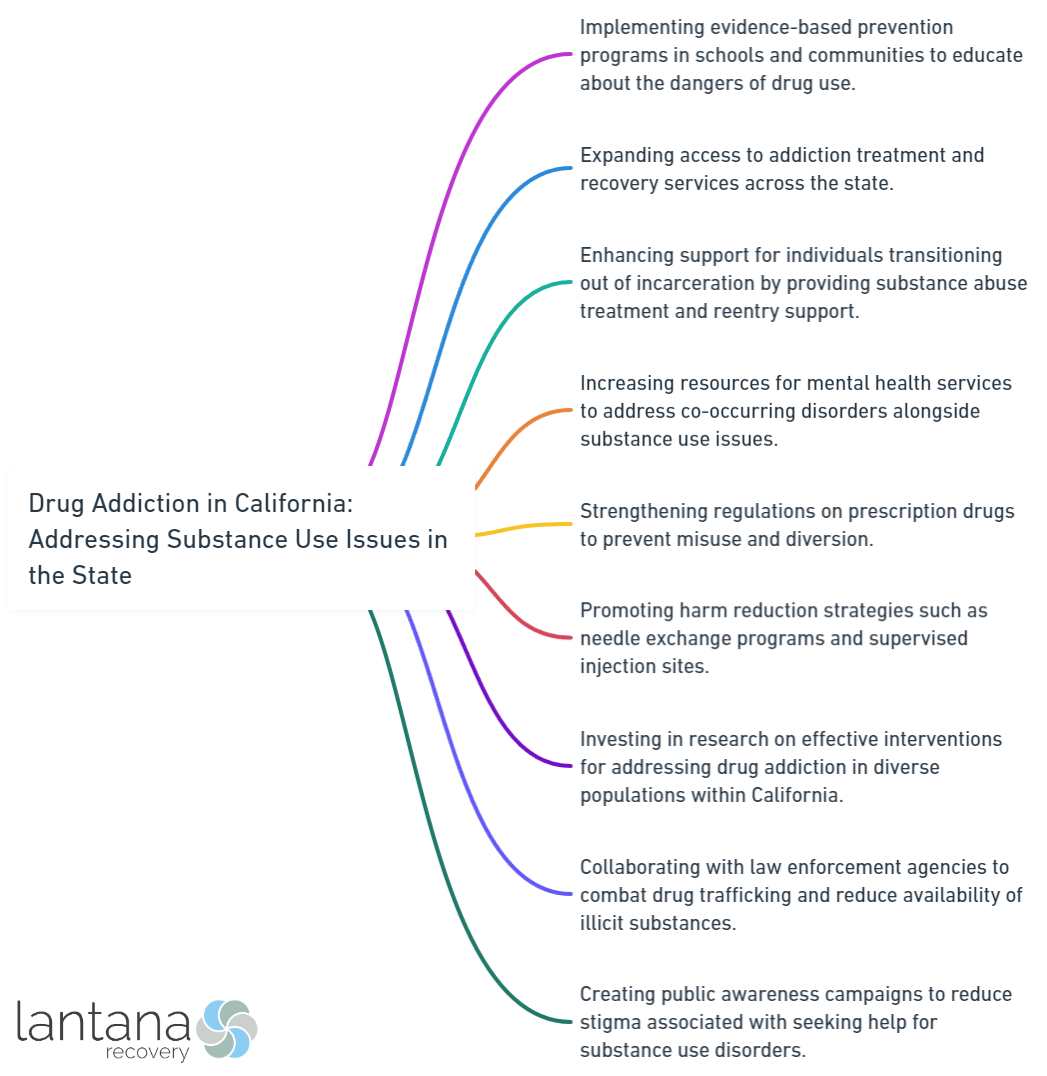Drug addiction is a significant issue that continues to plague California, with profound implications for individuals and communities. Understanding the scope of drug addiction in the state is crucial in addressing this pressing concern. According to the Substance Abuse and Mental Health Services Administration (SAMHSA), California has one of the highest rates of substance use disorders in the United States.
The prevalence of drug addiction in California is alarming. Countless individuals struggle with addiction to various substances, ranging from stimulants, opioids, marijuana, to methamphetamine. This widespread addiction has severe repercussions on individuals’ physical and mental health, as well as on families, communities, and society as a whole.
Some of the most commonly abused drugs in California include stimulants, opioids, marijuana, and methamphetamine. These substances pose significant risks and contribute to the escalating drug addiction crisis in the state.
Several factors contribute to drug addiction in California. Social and environmental factors, such as poverty, lack of access to healthcare, and exposure to high-risk environments, play a role in the prevalence of addiction. easy access to prescription drugs and the presence of mental health issues and co-occurring disorders contribute to the complex nature of addiction among individuals in the state.
Addressing the drug addiction crisis in California requires a multifaceted approach. Prevention strategies aimed at educating communities and implementing targeted interventions are vital in reducing the onset of substance use disorders. Treatment options, including evidence-based therapies and medication-assisted treatments, play a crucial role in helping individuals recover from addiction. Furthermore, the availability of recovery support services is essential to support individuals in their journey towards long-term sobriety.
Policy and legislative efforts are also necessary to address the drug addiction crisis comprehensively. State and local initiatives must be implemented to enhance access to treatment, promote harm reduction strategies, and support community-based organizations. law enforcement and criminal justice reforms should focus on diverting individuals with substance use disorders towards treatment and rehabilitation instead of imprisonment.
By acknowledging the scope of drug addiction, understanding the commonly abused drugs, recognizing contributing factors, and implementing comprehensive strategies, California can work towards effectively addressing the drug addiction crisis and helping individuals find the support they need for recovery.

The Scope of Drug Addiction in California
California is grappling with a serious issue that has far-reaching consequences – drug addiction. In this section, we delve into the scope of this problem, shedding light on the prevalence of drug addiction across the state. Additionally, we explore the impact that drug addiction has on both individuals and communities, revealing the devastating effects that it has on various aspects of Californian society. Brace yourself for eye-opening insights into the real challenges faced in tackling substance abuse in the Golden State.
The Prevalence of Drug Addiction in the State
If you’re staying informed with drug addiction news, you’d know that the prevalence of drug addiction in the state of California is alarmingly high. Drug addiction exerts a profound influence on both individuals and communities. It results in various health issues, financial burdens, elevated crime rates, and strained relationships. Moreover, its repercussions extend to communities, hampering productivity, social cohesion, and overall well-being.
Several factors contribute to the heightened prevalence of drug addiction in California. Social and environmental factors, such as poverty, unemployment, and limited access to education, play a pivotal role. Additionally, the easy availability of prescription drugs and the coexistence of mental health and co-occurring disorders further exacerbate the problem.
Resolving the drug addiction crisis in California necessitates a comprehensive and multi-faceted approach. Prevention strategies should primarily focus on education and generating awareness about the risks and consequences associated with substance abuse. Simultaneously, it is imperative to ensure the availability and accessibility of various treatment options, including evidence-based therapies and medication-assisted treatment. Moreover, the implementation of recovery support services, such as counseling from experts at Lantana Recovery and support groups, is vital to assist individuals throughout their journey toward recovery.
The Impact of Drug Addiction on Individuals and Communities
Drug addiction has a significant impact on both individuals and communities. It greatly affects their physical and mental well-being, leading to various health problems and infectious diseases. Moreover, it puts a strain on relationships and support systems, resulting in feelings of isolation. Additionally, the financial burden caused by drug addiction is substantial, often leading to instability and poverty.
Furthermore, drug addiction is strongly associated with crime and violence, perpetuating a harmful cycle within communities. As a result, this puts a strain on healthcare and social services, increasing the demand for resources.
However, by implementing early intervention and providing comprehensive addiction treatment, the impact of drug addiction can be reduced. It is crucial to prioritize prevention, raise awareness, and establish accessible support systems to help individuals who are struggling with addiction.

Commonly Abused Drugs in California
California’s drug addiction crisis is a pressing issue, and understanding the commonly abused drugs in the state is crucial. In this section, we will dive into the world of stimulants, opioids, marijuana, and methamphetamine. Get ready to explore the trends, impact, and consequences of these substances, as we shed light on the drug landscape in California.
Stimulants
Stimulants increase alertness, attention, and energy levels. In California, these drugs are commonly abused and have serious consequences. Here are some important facts about stimulants:
- Types of Cocaine, amphetamines, and prescription medications like Adderall and Ritalin are stimulants.
- Physical Effects: Stimulants can increase heart rate, blood pressure, and body temperature. They can also cause decreased appetite, insomnia, and increased energy.
- Psychological Effects: Stimulants can produce feelings of euphoria, increased confidence, and heightened alertness. However, they can also lead to anxiety, irritability, and paranoia.
- Addiction Potential: Stimulants are highly addictive and can lead to dependence with regular use. Prolonged use can have detrimental effects on physical and mental health.
- Risks and Dangers: Chronic stimulant abuse can result in cardiovascular problems, respiratory issues, and neurological damage. It can also lead to financial difficulties, strained relationships, and legal problems.
True Story: John, a young man from California, started using stimulants to stay awake and study for long hours. Initially, he experienced increased focus and productivity, but soon, he found himself unable to function without the drugs. His health deteriorated, and his relationships suffered. With the support of his family and professional treatment, John was able to overcome his addiction and rebuild his life. Today, he shares his story to raise awareness about the dangers of stimulant abuse and the importance of seeking help.
Opioids
Opioids are commonly abused drugs in California, posing a significant threat to individuals and communities. They include prescription painkillers like oxycodone and hydrocodone, as well as illegal drugs like heroin. The misuse of opioids has reached alarming levels in the state. Worldwide, in 2019 about 600,000 deaths were attributable to drug use. Close to 80% of these deaths are related to opioids, with about 25% of those deaths caused by opioid overdose. This highlights the urgent need for effective interventions.
Opioid addiction has devastating consequences for individuals and communities, causing loss of employment, financial instability, and strained relationships. It also strains healthcare systems and first responders. Social and environmental factors, easy access to prescription drugs, and the presence of mental health and co-occurring disorders contribute to the opioid crisis in California.
To address the opioid crisis, prevention strategies are crucial. These may include educational programs and awareness campaigns for individuals and healthcare professionals. Treatment options like medication-assisted treatment and counseling should be readily available and accessible. Recovery support services, such as peer support groups and rehabilitation programs, are vital for individuals seeking to overcome opioid addiction.
Policy and legislative efforts are critical in combating the opioid crisis. State and local initiatives should focus on increasing access to treatment and recovery services, as well as implementing stricter regulations on opioid prescribing practices. Law enforcement and criminal justice reforms should prioritize diversion programs to steer individuals toward treatment instead of incarceration.
Marijuana
Marijuana is a commonly abused drug in California. Understanding its impact and factors contributing to its use can help address substance use issues related to marijuana in the state.
- Health effects: Marijuana use has short-term and long-term effects on health. Short-term effects include impaired memory and cognition, increased heart rate, and altered judgment. Long-term marijuana use can lead to respiratory problems, mental health issues, and dependency.
- Legality: Medical marijuana use is legal in California, but it is important to know and follow the state’s regulations. Recreational use is also legal for individuals aged 21 and older.
- Social and cultural acceptance: Marijuana’s social and cultural acceptance has increased in recent years. However, its use can still have potential impacts on personal and professional relationships, as well as legal consequences.
- Risks and benefits: Marijuana use has both potential risks and benefits for individuals. Evaluating these factors and making informed decisions is crucial. Consulting with healthcare professionals can provide valuable guidance.
- Education and prevention: Education about the risks and consequences of marijuana use is an important prevention strategy. Providing accurate information about the health effects and legal regulations can help individuals make responsible choices.
- Access and availability: Marijuana can be legally purchased through licensed dispensaries. However, responsible use and avoiding excessive consumption are essential to prevent dependency and other negative consequences.
Methamphetamine
Methamphetamine, also known as meth, is a highly addictive stimulant drug. It has harmful effects on individuals and communities in California. Here are some important facts about methamphetamine:
- Methamphetamine prevalence: Methamphetamine abuse is a significant problem in California. It is one of the most commonly abused drugs in the state, leading to a high addiction rate.
- Impact on individuals: Methamphetamine use has severe physical, psychological, and social consequences for individuals. It can cause addiction, cognitive impairment, violent behavior, and increased risk-taking.
- Impact on communities: Methamphetamine addiction affects not only individuals but also communities. It strains healthcare resources, increases crime rates, and disrupts neighborhoods.
- Availability and use: Methamphetamine is often made in illegal labs, making it easily accessible in California. It can be smoked, snorted, injected, or taken orally, and its intense high, and long-lasting effects contribute to its addictive nature.
- Health risks: Methamphetamine use poses various health risks, including problems with the heart, lungs, teeth (known as “meth mouth”), and mental health disorders such as anxiety, depression, and psychosis.
- Treatment options: Effective treatment for methamphetamine addiction is available in California. It often involves a combination of therapies, counseling, support groups, and medication-assisted treatment to address the physical and psychological aspects of addiction.
- Prevention strategies: Preventing methamphetamine addiction requires a comprehensive approach. Educating communities, implementing school-based prevention programs, supporting law enforcement efforts, and promoting access to treatment and recovery resources are crucial in combating methamphetamine abuse.
Addressing the methamphetamine crisis in California through targeted prevention efforts, effective treatment options, and robust support services is essential for creating a healthier and safer community for all.

The Factors Contributing to Drug Addiction in California
California, known for its sunny beaches and vibrant cities, is also grappling with a deep-rooted issue: drug addiction. In this section, we will delve into the factors that contribute to this widespread problem. From the social and environmental influences to the concerning accessibility of prescription drugs, we will uncover the intricate web of causes behind drug addiction in California. Additionally, we will explore the critical role that mental health and co-occurring disorders play in exacerbating substance use issues in the state. So, buckle up as we uncover the underlying factors that contribute to California’s drug addiction crisis.
Social and Environmental Factors
When learning about the biopsychosocial model of substance abuse, social and environmental factors play a significant role. It is crucial to gain an understanding of and address these factors in order to effectively combat the drug addiction crisis in the state.
- Peer groups: Peer pressure and the desire to fit in can lead individuals to experiment with drugs. The social environment, including friends, family, and community, greatly impacts an individual’s likelihood of engaging in drug use.
- Availability of drugs: Certain communities have easy accessibility and availability of drugs, which leads to higher rates of drug addiction. Neighborhoods with high crime rates and limited resources are particularly susceptible to drug abuse.
- Exposure to trauma: Individuals who have experienced trauma, such as physical or emotional abuse, are at a higher risk of developing drug addiction as a coping mechanism. Unstable living conditions or exposure to violence can also contribute to substance abuse.
- Media influence: The portrayal of drug use in media affects perceptions and attitudes towards drugs. When drug use is glamorized or normalized, it increases the likelihood of experimentation and addiction.
- Education and socioeconomic status: Limited access to quality education and job opportunities, as well as socioeconomic disparities, make individuals more vulnerable to drug addiction. Lack of resources and opportunities push individuals to turn to drugs as a means of escape or to cope with challenging circumstances.
Addressing these social and environmental factors requires a comprehensive approach. It should include education, community involvement, and social support systems. Prevention programs focused on empowering youth, promoting healthy coping mechanisms, and providing resources for support and rehabilitation are crucial. Creating supportive environments that prioritize mental health, address socioeconomic disparities, and promote healthy lifestyles is essential. By addressing these factors, we can help reduce the prevalence of drug addiction and support individuals in their journey toward recovery.
Access to Prescription Drugs
Access to prescription drugs is a significant contributing factor to the rampant drug addiction problem in California. The state has seen a rise in substance abuse cases due to the easy availability and misuse of these medications. Prescription medications, including opioids, benzodiazepines, and stimulants, are unfortunately commonly abused in California. Many individuals obtain these drugs through improper or illegal means, such as doctor shopping or purchasing from illicit sources.
The pharmaceutical industry also plays a role in making prescription drugs easily accessible. In some cases, healthcare professionals overprescribe medications, resulting in an excess supply in the community. Societal factors contribute to the prevalence of prescription drug misuse in California. The culture of self-medication and seeking quick relief from physical or emotional pain leads many individuals to turn to prescription drugs for non-medical purposes.
Efforts have been made in recent years to address this issue. Prescription drug monitoring programs have been implemented to track prescriptions and identify potential cases of misuse. Additionally, numerous initiatives aim to educate healthcare professionals and the public about the risks and proper use of prescription medications.
To effectively combat this problem, it is crucial to implement stricter regulations and monitoring systems to control access to prescription drugs. Healthcare professionals must adhere to prescribing guidelines and be vigilant in identifying signs of addiction. Public education campaigns are also vital in raising awareness about the risks and consequences of misusing prescription medications.
Pro-tip: It’s important to dispose of unused or expired prescription drugs properly at designated collection sites to prevent misuse or accidental consumption by others.
Mental Health and Co-occurring Disorders
Mental health and co-occurring disorders play a significant role in the issue of drug addiction in California. “Substance use disorder (SUD) is associated with a high risk of physical and mental illness such as anxiety, depression, personality disorders, eating disorders, and abnormal mood changes” (The impact of SUD on mental health, Kim et al., 2020.) These co-occurring disorders can exacerbate substance abuse problems and create additional challenges for long-term recovery.
The relationship between mental health and drug addiction is intricate, often resulting in a cycle of self-medication using drugs or alcohol. In order to effectively address drug addiction, it is essential to treat both the substance use disorder and the co-occurring mental health disorder concurrently. Integrated treatment that combines therapy and medication is vital for promoting overall well-being in individuals.
Having access to mental health services is crucial in tackling the drug addiction crisis in California. It is important to ensure that individuals have comprehensive mental health care and addiction treatment programs readily available to effectively address co-occurring disorders.
If you or someone you know is struggling with drug addiction and a co-occurring mental health disorder, seeking professional help is essential. Integrated treatment programs from an institution like Lantana, such as dual diagnosis programs, can provide personalized support for addressing both mental health and addiction issues simultaneously, thereby increasing the likelihood of successful recovery.

Addressing the Drug Addiction Crisis in California
California is grappling with a drug addiction crisis, but there is hope on the horizon. In this section, we will uncover effective strategies to address this pressing issue. From prevention to treatment and recovery support services, we will explore the tools and resources available to combat drug addiction in California. Get ready to discover how the state is tackling this crisis head-on and paving the way for a healthier future.
Prevention Strategies
When addressing drug addiction in California, prevention strategies are crucial for reducing substance abuse. Effective prevention strategies include:
- Educational Programs: Implement comprehensive drug education programs in schools and communities to raise awareness about the risks and consequences of drug use.
- Early Intervention: Identify and support individuals at high risk of developing substance use disorders, such as those with a family history of addiction or mental health challenges.
- Community Engagement: Involve community leaders, organizations, and parents to create a supportive and drug-free environment for young people. Encourage community-based activities that promote positive behaviors.
- Prescription Drug Monitoring Programs: Strengthen and enforce regulations regarding prescription drugs to prevent excessive use, diversion, and addiction. Increase access to medication disposal sites for safe disposal of unused medications.
- Media Campaigns: Develop targeted media campaigns to raise awareness about the dangers of drug use and promote healthy alternatives. Use various communication channels to reach different age groups and demographics.
To enhance the effectiveness of these prevention strategies, it is crucial to allocate necessary resources, collaborate with law enforcement agencies, and regularly evaluate and update programs based on emerging trends and research findings. By implementing these prevention strategies, California can take significant steps toward reducing drug addiction and creating safer and healthier communities for its residents.
Treatment Options
When it comes to addressing drug addiction in California, several treatment options are available:
-
Detoxification: Safely remove drugs or toxins from the body through medical supervision and support to manage withdrawal symptoms.
-
Inpatient Rehabilitation: Provide a structured and supportive environment for individuals to focus on recovery with 24/7 care, therapy sessions, and support groups.
-
Outpatient Rehabilitation: Receive outpatient treatment near you while continuing your daily life with flexibility in scheduling and counseling, therapy, and medication-assisted treatment.
-
Medication-Assisted Treatment (MAT): Combine medications like methadone or buprenorphine with therapy and counseling to overcome opioid addiction.
-
Cognitive-Behavioral Therapy (CBT): Help individuals identify and change negative patterns of thinking and behavior related to drug addiction.
-
Support Groups: Provide a sense of community and support for individuals in recovery, such as Narcotics Anonymous.
-
Sober Living Homes: Structured living environments where individuals in recovery can reside while transitioning back into society, offering support and accountability.
It is important to note that treatment options may vary depending on the specific needs of each individual. The right treatment approach should be tailored to address the unique circumstances and challenges of the person seeking help.
Recovery Support Services
Recovery support services are crucial for overcoming drug addiction in California. These services, including peer support, counseling and therapy, sober living homes, aftercare planning, and family involvement, offer assistance and support in various ways. Here are some important aspects to consider when it comes to incorporating recovery support services:
1. Peer Support: Peer support groups like Narcotics Anonymous play a vital role in providing a safe and understanding environment for individuals facing the same challenges. These groups foster a sense of community and provide a strong support network.
2. Counseling and Therapy: Professional counseling and therapy from experts at Lantana are essential in addressing the underlying issues that contribute to addiction. Therapists offer guidance and strategies to overcome cravings, develop healthy coping mechanisms, and work through emotional challenges.
3. Sober Living Homes: Sober living homes provide a structured and supportive environment for individuals transitioning from addiction treatment to independent living. These homes offer substance-free living and communal support, which greatly assist in maintaining sobriety and reintegrating into society.
4. Aftercare Planning: Recovery support services should always include personalized long-term recovery plans. These plans may involve ongoing therapy, strategies for preventing relapse, and assistance in finding employment or housing.
5. Family Involvement: Family therapy and education play a crucial role in the recovery process. These services help family members understand addiction, rebuild relationships, and provide ongoing support to the individual in recovery.
By incorporating these recovery support services, individuals in California can greatly enhance their chances of achieving long-term sobriety and overall well-being. It is of utmost importance to tailor support services to meet each individual’s specific needs and goals.

Policy and Legislative Efforts
Over the years, California has been diligent in combating drug addiction and addressing substance use issues within its boundaries.
In this section, we’ll explore the dynamic landscape of policy and legislative efforts in the state. From state and local initiatives to law enforcement and criminal justice reforms, we’ll uncover the various strategies and actions taken to tackle this pressing issue head-on.
State and Local Initiatives
State and local initiatives play a vital role in tackling the drug addiction crisis in California. These initiatives focus on various aspects such as prevention, treatment, support services, policy reforms, and legislative changes. Here are a few examples of these initiatives:
- Community education programs: State and local governments can organize educational programs to raise awareness about the hazards of drug addiction and provide information on preventive measures. These programs can be conducted in schools, community centers, and other public spaces.
- Drug take-back programs: State and local governments can establish programs for the safe disposal of prescription drugs to prevent their misuse. These initiatives allow individuals to properly dispose of unused or expired medications, thus reducing the availability of drugs for potential misuse.
- Expansion of treatment facilities: It is crucial to invest in the expansion of treatment facilities to meet the increasing demand for addiction treatment services. State and local governments can allocate funds to enhance the number of treatment centers, ensuring that individuals have easy access to quality care when they seek help.
- Support for recovery housing: State and local initiatives can provide support for recovery housing, which offers a stable and drug-free environment for individuals in recovery. This support includes funding for sober living homes and the implementation of regulations to guarantee the safety and effectiveness of these facilities.
To effectively address the drug addiction crisis in California, state and local governments should collaborate with community organizations, healthcare providers, and law enforcement agencies to provide outpatient care near you, for example. By working together, these initiatives can significantly reduce substance abuse and provide valuable support to individuals on their journey to recovery.
Law Enforcement and Criminal Justice Reforms
Law enforcement and criminal justice reforms are essential for addressing the drug addiction crisis in California. These reforms ensure that individuals struggling with substance abuse receive the necessary support and treatment they require. Implementing effective strategies in law enforcement is crucial. By targeting drug traffickers and suppliers, law enforcement agencies actively combat drug addiction. Increased cooperation between local police departments and federal agencies helps to apprehend and prosecute drug offenders.
Moreover, diversion and rehabilitation programs should be prioritized by law enforcement. Instead of focusing solely on punishment, these programs redirect individuals with substance abuse issues toward treatment and rehabilitation. By doing so, they provide the necessary support to break the cycle of addiction and facilitate successful reintegration into society.
Considering alternatives to incarceration is also important. Non-violent drug offenders should be given options such as participation in drug courts or community-based supervision programs. These alternatives place an emphasis on treatment and rehabilitation, reducing the burden on the criminal justice system and promoting better long-term outcomes for those struggling with addiction.
Providing law enforcement with training and resources is crucial. Training should encompass areas such as substance abuse, mental health issues, and de-escalation techniques. This enhances law enforcement’s ability to effectively respond to drug-related incidents. Establishing partnerships with addiction treatment providers also ensures a coordinated and comprehensive response to the drug addiction crisis.
By implementing these law enforcement and criminal justice reforms, California can effectively address the drug addiction crisis and ensure that individuals struggling with addiction receive the necessary support they need. It is crucial to foster collaborative partnerships between law enforcement agencies, healthcare providers, and community organizations. Working together, they can create a comprehensive approach to addressing drug addiction and promoting public safety.
Frequently Asked Questions
What is the executive summary of the substance use report by the California Health Care Foundation?
The executive summary of the substance use report states that substance use disorders (SUDs) are recognized as chronic illnesses in California’s health care system. However, only 10% of people with SUDs received treatment in the last year. The report highlights the need to address SUDs as chronic illnesses and the low treatment rates in the state.
What are the effects of substance abuse in California?
Substance abuse in California has significant effects on individuals and society. It is estimated that 7.6% of residents aged 12 and above in Los Angeles County have a substance use disorder, and 15.2% have used illicit drugs in the past month. Each year, 2,579 people in Los Angeles County die from causes related to alcohol or drugs, and there are 134,531 emergency department visits related to substance abuse.
How is substance abuse addressed during National Substance Abuse Prevention Month in October?
National Substance Abuse Prevention Month, celebrated in October, aims to honor those in recovery and remember those who have lost their lives to addiction. It is a time to raise awareness about the extent of the problem and the importance of prevention. Various organizations and initiatives promote prevention resources and community education to reduce stigma and increase awareness of available treatment services.
What is the current state of substance use in California according to the California Health Care Foundation report?
The California Health Care Foundation report provides an overview of substance use and addiction in the state. It highlights the prevalence of substance use disorders and the gap between acknowledging SUDs as chronic illnesses and the low percentage of people receiving treatment. The report aims to provide an understanding of the challenges and opportunities in addressing substance use disorders in California.
What reforms are recommended for California’s substance abuse treatment system by the Little Hoover Commission?
The Little Hoover Commission recommends reforms in California’s substance abuse treatment system. They suggest a new treatment system model that emphasizes early intervention and evidence-based strategies. The Commission calls for improved outcomes and accountability, integration of substance abuse treatment into health and human services, and the creation of a substance abuse policy council and a joint committee on alcohol and drug abuse. They also recommend transforming programs for nonviolent drug offenders by developing standards for a continuum of services and increasing the use of drug court models.
What are the available resources for addressing addiction and substance abuse in Los Angeles?
In Los Angeles County, there are resources available to address addiction and substance abuse. The county offers an online Service & Bed Availability Tool (SBAT) for those seeking substance use disorder treatment. Mission Harbor Behavioral Health provides outpatient substance abuse and mental health services in Los Angeles. However, there are barriers to receiving treatment in Los Angeles, including limited availability of inpatient services and limited integration of substance use services in primary care settings. Efforts are being made to expand substance use treatment services by offering additional training to primary care providers, attracting new workers to the addiction treatment field, and increasing the number of providers that accept Medicaid insurance.









